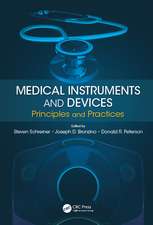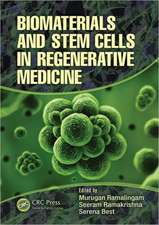In-Vitro Diagnostic Devices: Introduction to Current Point-of-Care Diagnostic Devices
Autor Chao-Min Cheng, Chen-Meng Kuan, Chien-Fu Chenen Limba Engleză Paperback – 15 oct 2016
In addition to summarizing and detailing developed diagnostic devices, this book will attempt to point out the possible future trends of development for point-of-care diagnostics using both scientifically based research and practical engineering needs with the aim to help novices comprehensively understand the development of point-of-care diagnostics. This includes demonstrating several common but critical principles and mechanisms used in point-of-care diagnostics that address practical needs (e.g., disease or healthcare monitoring) using two well-developed examples so far: 1) blood glucose meters(via electrochemistry); and, 2) pregnancy tests (via lateral flow assay).
Readers of this book will come to fully comprehend how to develop point-of-care diagnostics devices, and will be inspired to contribute to a critical global cause – the development of inexpensive, effective, and portable in vitro diagnostics tools (for any purpose) that can be used either at home or in resource limited areas.
| Toate formatele și edițiile | Preț | Express |
|---|---|---|
| Paperback (1) | 705.83 lei 6-8 săpt. | |
| Springer International Publishing – 15 oct 2016 | 705.83 lei 6-8 săpt. | |
| Hardback (1) | 712.60 lei 6-8 săpt. | |
| Springer International Publishing – 24 iul 2015 | 712.60 lei 6-8 săpt. |
Preț: 705.83 lei
Preț vechi: 742.98 lei
-5% Nou
Puncte Express: 1059
Preț estimativ în valută:
135.08€ • 146.67$ • 113.46£
135.08€ • 146.67$ • 113.46£
Carte tipărită la comandă
Livrare economică 22 aprilie-06 mai
Preluare comenzi: 021 569.72.76
Specificații
ISBN-13: 9783319371740
ISBN-10: 3319371746
Pagini: 112
Ilustrații: VI, 106 p. 50 illus., 40 illus. in color.
Dimensiuni: 155 x 235 x 6 mm
Greutate: 0.17 kg
Ediția:Softcover reprint of the original 1st ed. 2016
Editura: Springer International Publishing
Colecția Springer
Locul publicării:Cham, Switzerland
ISBN-10: 3319371746
Pagini: 112
Ilustrații: VI, 106 p. 50 illus., 40 illus. in color.
Dimensiuni: 155 x 235 x 6 mm
Greutate: 0.17 kg
Ediția:Softcover reprint of the original 1st ed. 2016
Editura: Springer International Publishing
Colecția Springer
Locul publicării:Cham, Switzerland
Cuprins
Introduction to In-Vitro Diagnostic Devices.- Polymeric-based In-Vitro Diagnostic Devices.- Low-cost In Vitro Diagnostic Technologies.- Glucose Sensor and its Potential Directions.
Notă biografică
Chao-Min Cheng
Chao-Min Cheng received his Ph. D. in Biomedical Engineering in 2009 from Carnegie Mellon University under the supervision of Prof. Philip R. LeDuc. He then did his post-doctoral training with Prof. George M. Whitesides at Harvard University where he helped develop paper diagnostic systems to address global public health concerns. He is currently an independent P.I., tenured Associate Professor, at National Tsing Hua University, Taiwan, where he started in the summer of 2011. He has been blessed to receive a Distinguished Young Investigator Research Grant from the National Science Council in Taiwan, and was awarded “Excellent Performance on Intellectual Property & Technology Transfer” by his school twice (2012 & 2013). He is currently an Acting Member of the International Affairs/Globalization Committee for the Biomedical Engineering Society (BMES), an Editorial Board Member for Sensor Letters and Journal of Cellular and Molecular Medicine and theGuest Editor for Talanta. In addition to his many academic contributions, Dr. Cheng serves as a consultant for biotechnologically relevant companies around the world with approximately 20 patent groups pending (in Taiwan, China, U.S.), and is the co-Founder of start-up companies in Taiwan and the U.S.
Chen-Meng Kuan
Chen-Meng Kuan is a Ph.D. student of the Institute of Nanoengineering and Microsystems at National Tsing Hua University, Taiwan. He received his M.S. from the Institute of Nanoengineering and Microsystems, National Tsing Hua University, in 2010 under the supervision of Prof. Chao-Min Cheng. His main research interest is to develop low-cost analytical devices for biochemical analysis. Specifically, he has worked and continues to work on the development of cotton-based, PDMS-based, and lignocellulosic-based analytical devices for on-site implementation of point-of-care testing and food safety analysis.
Chien-Fu Chen
Chien-Fu Chen is an Assistant Professor at the Graduate Institute of Biomedical Engineering, National Chung Hsing University, Taiwan. He received his Ph. D. from the Institute of Applied Mechanics, National Taiwan University in 2007. He then did his postdoctoral research on sensing platforms using carbon-based nanomaterials at the University of Maryland, College Park with Cheng S. Lee and YuHuang Wang in the Department of Chemistry and Biochemistry, and on polymeric-based liquid chromatography systems with Don L. DeVoe in the Department of Mechanical Engineering from 2007 to 2011. Prof. Chen’s research focuses on the development of miniaturized systems using micro/nanomaterials for biomedical point-of-care sensing applications that are affordable, sensitive, specific, user-friendly, rapid, robust, and are operable without additional complicated equipment. In addition to being a PI on several research projects, he has also served on program committees and as section chair for over 10 workshops and conferences. In 2014, he received the Young Faculty Award from the College of Engineering, National Chung Hsing University.
Chao-Min Cheng received his Ph. D. in Biomedical Engineering in 2009 from Carnegie Mellon University under the supervision of Prof. Philip R. LeDuc. He then did his post-doctoral training with Prof. George M. Whitesides at Harvard University where he helped develop paper diagnostic systems to address global public health concerns. He is currently an independent P.I., tenured Associate Professor, at National Tsing Hua University, Taiwan, where he started in the summer of 2011. He has been blessed to receive a Distinguished Young Investigator Research Grant from the National Science Council in Taiwan, and was awarded “Excellent Performance on Intellectual Property & Technology Transfer” by his school twice (2012 & 2013). He is currently an Acting Member of the International Affairs/Globalization Committee for the Biomedical Engineering Society (BMES), an Editorial Board Member for Sensor Letters and Journal of Cellular and Molecular Medicine and theGuest Editor for Talanta. In addition to his many academic contributions, Dr. Cheng serves as a consultant for biotechnologically relevant companies around the world with approximately 20 patent groups pending (in Taiwan, China, U.S.), and is the co-Founder of start-up companies in Taiwan and the U.S.
Chen-Meng Kuan
Chen-Meng Kuan is a Ph.D. student of the Institute of Nanoengineering and Microsystems at National Tsing Hua University, Taiwan. He received his M.S. from the Institute of Nanoengineering and Microsystems, National Tsing Hua University, in 2010 under the supervision of Prof. Chao-Min Cheng. His main research interest is to develop low-cost analytical devices for biochemical analysis. Specifically, he has worked and continues to work on the development of cotton-based, PDMS-based, and lignocellulosic-based analytical devices for on-site implementation of point-of-care testing and food safety analysis.
Chien-Fu Chen
Chien-Fu Chen is an Assistant Professor at the Graduate Institute of Biomedical Engineering, National Chung Hsing University, Taiwan. He received his Ph. D. from the Institute of Applied Mechanics, National Taiwan University in 2007. He then did his postdoctoral research on sensing platforms using carbon-based nanomaterials at the University of Maryland, College Park with Cheng S. Lee and YuHuang Wang in the Department of Chemistry and Biochemistry, and on polymeric-based liquid chromatography systems with Don L. DeVoe in the Department of Mechanical Engineering from 2007 to 2011. Prof. Chen’s research focuses on the development of miniaturized systems using micro/nanomaterials for biomedical point-of-care sensing applications that are affordable, sensitive, specific, user-friendly, rapid, robust, and are operable without additional complicated equipment. In addition to being a PI on several research projects, he has also served on program committees and as section chair for over 10 workshops and conferences. In 2014, he received the Young Faculty Award from the College of Engineering, National Chung Hsing University.
Textul de pe ultima copertă
Addressing the origin, current status, and future development of point-of-care diagnostics, and serving to integrate knowledge and tools from Analytical Chemistry, Bioengineering, Biomaterials, and Nanotechnology, this book focusses on addressing the collective and combined needs of industry and academia (including medical schools) to effectively conduct interdisciplinary research.
In addition to summarizing and detailing developed diagnostic devices, this book will attempt to point out the possible future trends of development for point-of-care diagnostics using both scientifically based research and practical engineering needs with the aim to help novices comprehensively understand the development of point-of-care diagnostics. This includes demonstrating several common but critical principles and mechanisms used in point-of-care diagnostics that address practical needs (e.g., disease or healthcare monitoring) using two well-developed examples so far: 1) blood glucose meters(via electrochemistry); and, 2) pregnancy tests (via lateral flow assay).
Readers of this book will come to fully comprehend how to develop point-of-care diagnostics devices, and will be inspired to contribute to a critical global cause – the development of inexpensive, effective, and portable in vitro diagnostics tools (for any purpose) that can be used either at home or in resource limited areas.
In addition to summarizing and detailing developed diagnostic devices, this book will attempt to point out the possible future trends of development for point-of-care diagnostics using both scientifically based research and practical engineering needs with the aim to help novices comprehensively understand the development of point-of-care diagnostics. This includes demonstrating several common but critical principles and mechanisms used in point-of-care diagnostics that address practical needs (e.g., disease or healthcare monitoring) using two well-developed examples so far: 1) blood glucose meters(via electrochemistry); and, 2) pregnancy tests (via lateral flow assay).
Readers of this book will come to fully comprehend how to develop point-of-care diagnostics devices, and will be inspired to contribute to a critical global cause – the development of inexpensive, effective, and portable in vitro diagnostics tools (for any purpose) that can be used either at home or in resource limited areas.
Caracteristici
Enriches understanding of point-of-care diagnostics and popular nanotechnology based assays, including blood-glucose and pregnancy test strip technology Features interdisciplinary analysis spanning the gap between laboratory and industry Addresses the origin, current status, and future development of point-of-care diagnostics addressing scientific research and practical engineering needs Includes supplementary material: sn.pub/extras











